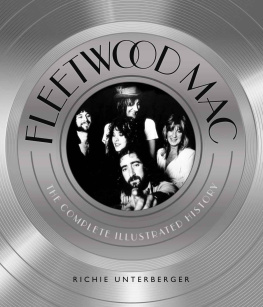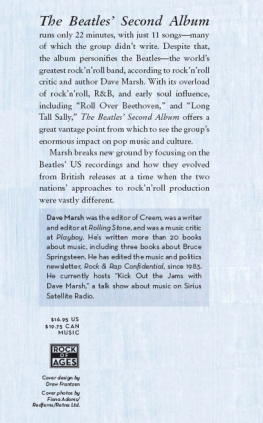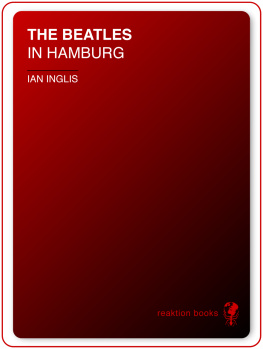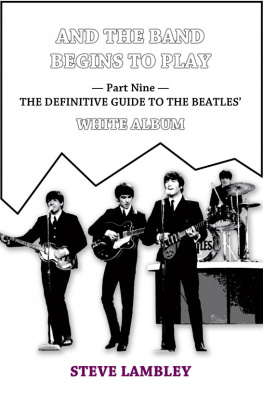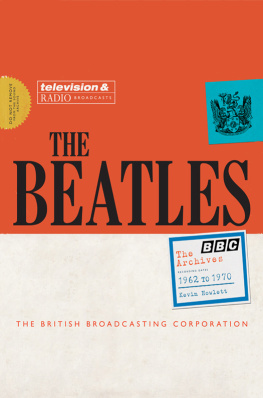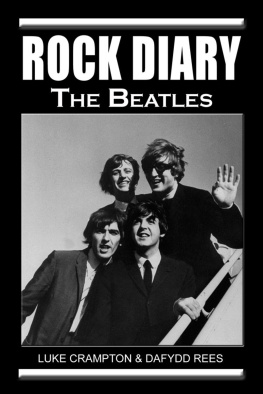The Unreleased Beatles: Music and Film
[Updated Ebook Edition]
By Richie Unterberger
Text copyright 2017 Richie Unterberger
All rights reserved
TABLE OF CONTENTS
When The Unreleased Beatles: Music and Film was first published in 2006, it was not just the culmination of a couple of years of research specifically dedicated to the bands unissued output. In a way, it was the culmination of 35 years or so of collecting unreleased Beatles. The quest began when I bought my first Beatles bootleg (and one of the very first Beatles bootlegs of all), Kum Back , at the age of eight in April 1970. By the time the book went to press in the late summer of 2006, Id done my best to track down every scrap of commercially unavailable recordings by the band, as well as many rare films, songs they gave away to other artists, songs they wrote but never put on tape, and other ephemera. The journey added several shelves of discs to my collection, but the marathon was worth it, leaving me feeling as if Id investigated every known corner of their unofficial discography.
As I write this, about ten years have passed. Its about 50 years since the Beatlemania exploded, first in Britain in 1963, then in the US the beginning of the following year. Its about 45 years since the hunt began for unreleased Beatles. Could there really be much else to find?
Yes, and no. Since the first edition was published, previously unreleased music has continued to trickle out, but it really is only a trickle. The undubbed, actual performances from the 1965 Shea Stadium concert; the full ten-minute take 20 of Revolution 1; George Harrisons January 26, 1969 demo of Isnt It a Pity; the full September 5, 1962 Cavern version of Kansas City/ Hey! Hey! Hey! Hey!; a couple other excerpts of the tape of the Quarrymen at the July 1957 church fte where John Lennon met Paul McCartneyall count as significant additions to the unreleased Beatles canon, though hardly among the major cornerstones. More often, the leaks have been crumbs from the feast, like a forty-second lo-fi excerpt of a live version of From Me to You from 1963, or a yet far lower-fi tape of their 1966 Memphis concerts.
On the official front, EMI/Apple continue their vigilant gatekeeping of the bands catalog. In the decade following 2006, the only major commercial release of previously unavailable material was 2013s two-CD set On Air: Live at the BBC Vol. 2 . When The Beatles Live at the Hollywood Bowl finally came out in September 2016, it added just three previously unreleased tracks from their performances at the venue in 1964 and 1965, though all three of their Hollywood Bowl concerts have long circulated in their entirety on bootleg. Yes, much chatter, as well as count-ins and slightly longer nonfaded endings, filled out the mixes you could construct of several dozen tracks on the video game The Beatles Rock Band . But that was expensive, the sources of the new mixes it generated uncertain, and overall an exasperating endeavor for collectors to make heads and tails of, especially those longtime fans not particularly enamored of the new technology.
In a surprise change from the established pattern, however, a deluxe box set edition of Sgt. Peppers Lonely Hearts Club Band was issued in May 2017, close to the 50th anniversary of the original LPs release. It marked the first instance in which a Beatles album was more or less given the bells-and-whistles treatment it deserved. True, the several dozen outtakes and alternate versions on the box were usually pretty similar (sometimes exactly so) to the official ones. Its also true that some bootlegged or known unreleased material from the Sgt. Pepper remains officially unavailable, or uncirculated. Still, the appearance of a fair amount of previously unreleased items from the vaults bodes well for a possible loosening of the generally tight-fisted policy toward dispensing tracks from the vaults.
As for videos, the sudden appearance of both Help! and Magical Mystery Tour on DVD with bonus features was welcome, if an expensive extravagance for the deluxe editions. Most, though not all, of their promo films came out on two DVD or Blu-ray discs on the three-disc package 1+ (which also included a reissue of the greatest-hits-of-sorts CD ). Yet Let It Be continues to molder in the vaults, despite hints that it too was in line for imminent release with added material. Such major documents as The Beatles at Shea Stadium , Around the Beatles , and their 1966 Tokyo concerts are still unavailable. And while their first US concert (on February 11, 1964 in Washington, DC) did come out, it could only be downloaded from iTunesanother aggravating inconvenience for those without the tools or inclination to acquire media in that format.
So in some senses, little has changed in the world of Unreleased Beatledom, deluxe Sgt. Pepper box to the contrary. But in others, everything has changed.
Even when the original edition of this book appeared in 2006, file-sharing had been making the free or mostly free exchange of music of all kinds, commercially available or not, more widespread than even the giddiest tech-heads would have predicted at the beginning of the 21 st century. Since then, the advent of YouTube and numerous other sites have made near-instant access to a seemingly infinite universe of music and videos possible. Many figures within and without the entertainment industry continue to vigorously debate the legality of this means of content distribution, and even whether its ethically proper to view or download it. The fact is, however, that millions if not billions of people are now using these services to hear and see material they were, until fairly recently, accustomed to buying or renting at retail outlets.
The impact upon the music industry has been enormous. Commercial labels and retail outlets are now fighting for their very survival. Youll hear and read (often online, ironically) plenty of news stories about that. Seldom discussed, however, is how its also impacted the distribution of music and videos that are not , and have often never been, commercially available. For rare Beatles, its no longer necessary, for the most part, to seek out physical bootlegs on LPs, CDs, or DVDs. Fair or not to the creators or their distributors, its mostly available at the touch of a few keystrokes. Its often not even necessary to go to the trouble of downloading bulky files, though sites specializing in those continue to lurk as well. For a new generation of Beatles fans, its as easy as it used to be for their parents (and grandparents) to watch TV or listen to the radio. And if youre one of those Luddites who doesnt know how to use computers to get at this stuff, just ask your kidsor their kids.
When I wrote the first edition of The Unreleased Beatles , I immediately determined it didnt make sense to write in terms of what had appeared on certain bootlegs, as there were so many, and so much overlap between them. Now it really doesnt make sense. Legions of young Beatles fans may have never even used a CD player, let alone a turntable. Music is assembled, collected, and often downloadedand you can download from many of those sites that let you listen to or watch audiovisual clips, though the legality of that is also hotly arguedin the form of tracks and files, not physical discs or tapes, let alone albums.
Those of us who grew up with LPs and 45s (and later on, CDs) might lament the passing of that age, when songs were specifically grouped on a circular object to create an impression or even make a statement. The upshot is, however, that unreleased music and video of all kinds is more or less freely available. Those who own or distribute such material in its commercial form continue to try to stamp it out, as they did when the ten-minute version of Revolution 1 tried to make the rounds. Theyve shut down some major sites that disseminate it, like megaupload. But like the campaign to stamp out the Beatles themselves back in 1964 in Detroit, its a losing battle. The audio tracks and film clips will continue to circulate, somewhere and some way, no matter how vigilant the web sheriffs try to suppress it.
Next page

